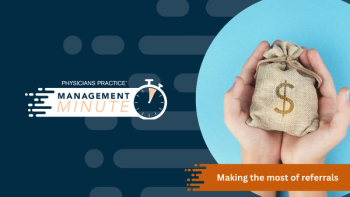
Copy Referring Physicians; Billing a Follow-Up Visit
Our coding expert discusses copying the referring physician on consults; coding follow-up visits; and selecting medical complexity for high-toxicity meds.
CC'ING THE PRIMARY-CARE PHYSICIAN
Q:My question is regarding consults. How would you recommend the specialist document that the office note has been sent to the primary-care physician? Is there a set time frame when the primary-care physician should receive the note?
A: As you know, when using consult codes, one requirement is that the consulting provider's opinion or advice be rendered in "written communication" back to the requesting provider.
Those words originated in the 1980s, and what was once a carbon copy (CC), Xerox copy, or facsimile (fax) sent to Dr. X may now take a different form. This is not a result of any change in official regulatory language but more the effect of the evolving medical record and the way it is used.
We don't have so many faxes or paper letters anymore. The word written must now include an electronic note, so however you want to document it, just make certain that the fact the communication was made is clear.
You need to leave some indication or footprint that the communication was made. In this era of EHRs, providers within the same group "task" another provider with the consult note or findings. One question to ask is whether this action is visible in the chart so that a reviewer could see that the intent of the requirement is met.
I see templated or pre-formatted language that accompanies consult notes that covers both the request and the report. "Note sent to Dr. X," "Dr. X notified of consult report in the EHR," or similar language should suffice. As with all "formatted" language - make it as personal as you can.
There is no specific time frame in which the communication needs to be made to my knowledge. Given that various tests may take some time to complete or get results from, it is logical that longer than the standard 24 hours to 48 hours for note completion would be reasonable. Use your judgment, but the note should certainly be forwarded within days of the completion of diagnostics and the necessary consult components.
BILLING FOLLOW-UPS
Q: Here is the scenario - a patient sees Dr. A and goes into the hospital for "lap chole" surgery (90-day global) on July 27, 2015, and is then discharged on July 29, 2015. On Aug. 5, 2015 he is readmitted for abdominal pain and Dr. B sees him as a consult. Is this second encounter a billable visit? And if so, is it an initial hospital code, a consult code, or would this be considered a post-op visit?
If Dr. A sees the patient as a consult and determines that abdominal pain is a complication of his lap chole surgery is that a billable visit (initial hospital or consult)? Or would it be a post op?
A: First we'd have to figure out the relationship between the doctors. There are several variables in this scenario and thus no one correct answer. If the doctors are of the same group and same specialty (it sounds like one might be covering for another, the way you asked the question), and the patient has Medicare, then it may not be a payable visit. Or if it is, you'll have to work for it.
If they are of the same group and same specialty and the patient does not have Medicare, then it is more likely payable with a modifier -24. You may even get a consult paid in this scenario.
To Medicare, since one doctor in the group was paid the global surgical fee, and that includes normal post-op care and complications of surgery, they would probably not regard this as a consult unless the patient were out of the global or the problem turned out to be unrelated to the surgery at all. The second doctor will surely take the position that he did the work and that he should get paid regardless of the outcome. But this is one of those times where the result or disposition of the consult affects the payableness of the encounter. You win some here and you lose some. You would need to bill Medicare for consults using the 99221-99223 series of CPT codes if you go this route. These would probably be denied in the first submission based on "global" considerations - and that's when you'd begin submitting documentation to show that the problem was unrelated. Commercial payers could recognize the consult or the 99231-99233 series with modifier 24 for the complication, if it is a complication. That said, modifier -24 indicates that this was a visit unrelated to the global - in this case a potential complication of the surgery - and thus not normal or usual post-op follow-up. Since this is a second hospitalization, and the question to the consultant is more directed toward the current problem (abdominal pain), a consult code should be allowed, especially if the answer is that the pain is not related to the original surgery. Of course you can bill anything you want but based on AMA and Medicare guidance, there are differences in how payers will look at this. Even if you were to be paid - these may still flag for RAC review and potential repayment.
HIGH-TOXICITY MEDS
Q:When prescribing medications that are of high toxicity, when does a provider get a level 5 visit - at the prescribing of the medication or on the days of monitoring with lab work?
A: This question seems to be directed at the Medical Decision Making (MDM) Table of Risk.
This is one of those elements that is often interpreted "generously." The bullet point in question reads: "Drug therapy requiring intensive monitoring for toxicity." It suggests that every time a high-risk agent is involved in an encounter then the provider gets "high" on the risk table that day.
Although there is not further clarification of what is meant by this bullet point, a conservative approach would suggest that you are either prescribing it new (with some discussion of risk and morbidity/mortality) or there is some significant activity involving that diagnosis and the treatment (something consistent with high risk, morbidity/mortality, although not with every encounter).
Some specialists look for a level 5 visit every time because someone is on methotrexate. This is probably not the spirit of this component. Remember that you need another decision-making component from Table A or B to match this - it doesn't stand alone. This is one of those MDM table "bullets" that tend to cause over-coding without medical necessity.
To support level 5 or high-level decision making we need to see high risk, complexity, or severity clearly documented. The presence of a particular medication and the monitoring of the same doesn't automatically do it.
Bill Dacey, CPC, MBA, MHA, is principal in the Dacey Group, a consulting firm dedicated to coding, billing, documentation, and compliance concerns. Dacey is an AAPC-certified instructor and has been active in physician training for more than 25 years.
This article was originally published in the November/December 2015 issue of Physicians Practice.
Newsletter
Optimize your practice with the Physicians Practice newsletter, offering management pearls, leadership tips, and business strategies tailored for practice administrators and physicians of any specialty.














